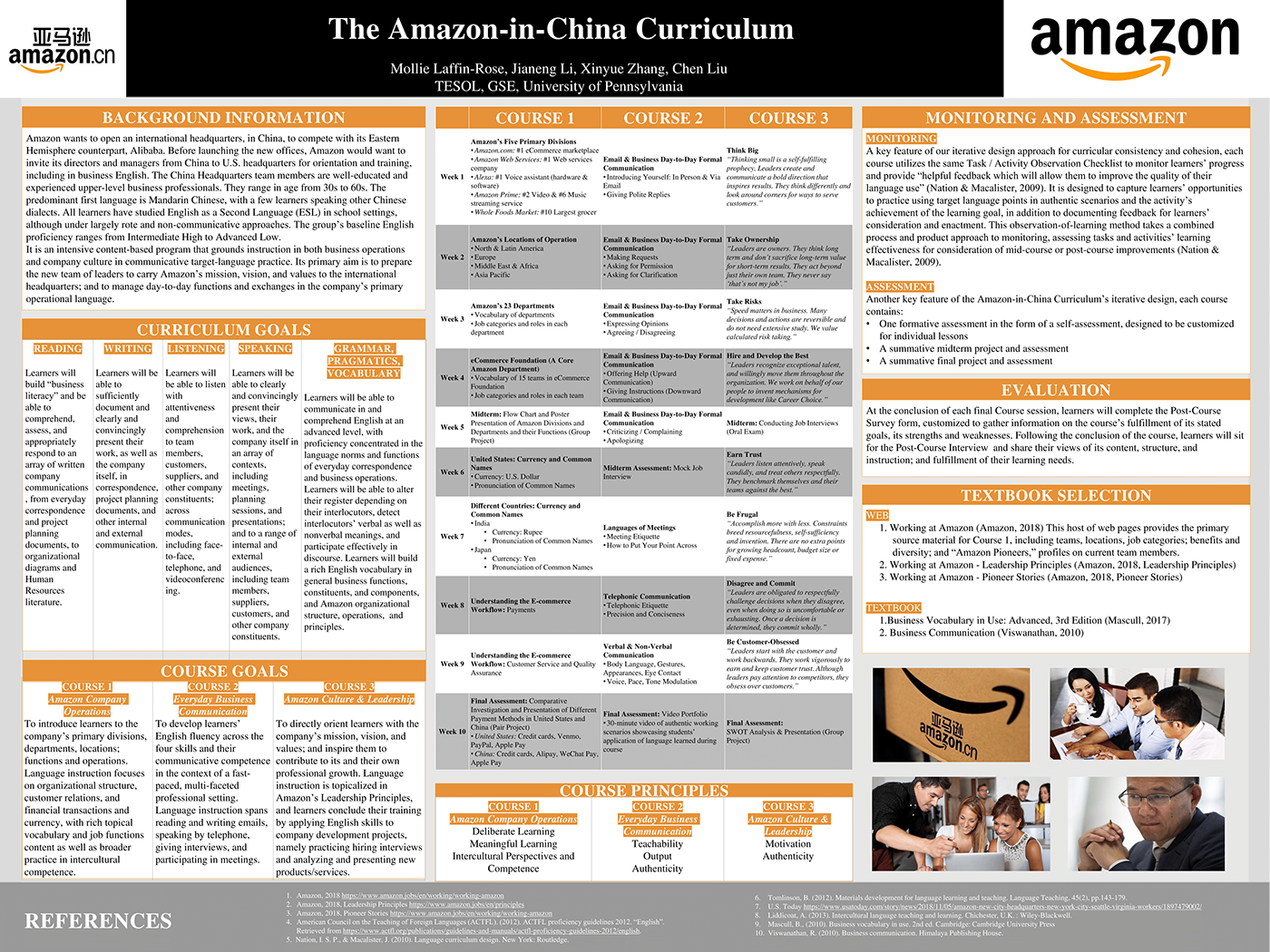"Amazon-in-China Curriculum"
A Workplace Training Curriculum for Leadership and Business English
The Amazon-in-China Curriculum was a group project designed during the Curriculum Design course of my Master’s Degree. The curriculum is developed for ‘imaginary’ trainees who are director-/manager-level employees from Amazon China, invited to the U.S. for a ten-week training. The primary goal of the curriculum is to directly orient the new Amazonians with the company’s mission, vision, and values. However, based on the needs assessments, foreign employees’ varied English proficiency levels will be foreseeably hindering the effectiveness of instruction. In order to create a welcoming learning environment for new Amazonians and enrich their learning experience, we decide to incorporate Business English as the second learning target into the curriculum, an endeavor to help the new employees not only succeed in the local context, but also thrive on a global scale with a good command of English.
Integrating language objectives in subject matter teaching entails lesson plans beyond a mere addition of language objectives to existing content training curricula. To make it an effective learning experience, tenets of Content-based Instruction (CBI) approach have become the guiding principles for the designing and enactment of two sets of independent but closely intertwined learning plans. Instructional techniques and pedagogical practices are designed around the CBI principles to meet the needs of the training plan and our trainee’s unique learning style.

Sample Lesson Plan Objectives
(Course 1 Week 1_lesson plan_section one)
Course title: Amazon Company Operation
Lesson one theme: Amazon's Five Primary Divisions—Amazon Web Services (AWS)
Lesson objectives:
*SWBAT=Students will be able to
- Content objectives:
1) SWBAT complete an AWS competitive analysis in China's market using PESTEL model.
2) SWBAT find the most desired market segment or establish several imagined client profiles in China's market to drive a substantial increase in revenue based on the results of the competitive analysis.
3) SWBAT make an informed decision of business development strategies in the identified niche segments.
4) SWBAT formulate the business plans with detailed action steps.
- Language objectives:
- Language objectives:
1) SWBAT individually and accurately extract key points/information from the assigned materials.
2) SWBAT explain and communicate the terms or key points intelligibly with other learners in verbal or written form.
3) SWBAT work collaboratively to synthesize the whole class's data into the PESTEL model.
4) SWBAT use at least five conjunctions to interpret the data in a logical fashion.
5) SWBAT use localized and contextualized pragmatics to make comments in a polite manner in order to arrive at a strategic solution.
Evidence of achievement:
- Content:
1) A complete and detailed PESTEL model
2) Hypothetical client profile
3) Business development plans
4) Action plans
- Language:
1) The representations of data (e.g. tables, graphs, and diagrams) from the source articles are accurate and free of significant errors.
2) Learners' discussion, negotiation, and presentation lead to consent business plans/strategies even though there are minor grammatical errors which do not impact their intelligibility.
Instructional approaches/principles:
- Advocate for learner-centered classrooms, teachers as facilitators.
- Provide sufficient and goal-oriented scaffolding to foster higher level of achievement with a good knowledge of learners' prior knowledge and business needs.
- Differentiate instructions of content teaching and language teaching to reduce working memory load for better memory consolidation.
Pedagogical practices:
- Content:
1) Warm-up activities: schema activation; elicitation from learners
2) Jigsaw reading
3) Collaborative tasks and activities
- Language:
1) Communicative language teaching (CLT) approach
2) Deductive teaching
3) Authentic materials (content topics) for language output activities
4) Iterative design for language learning (practice) using (adapted) content topics as contexts
5) Problem-solving tasks and activities




